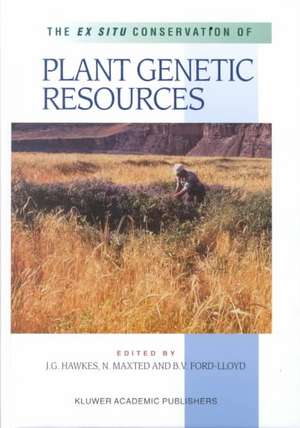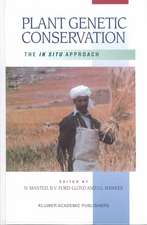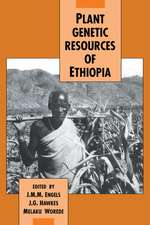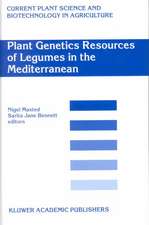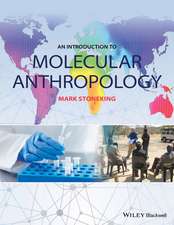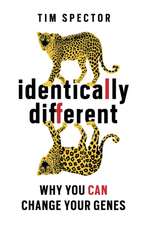The Ex Situ Conservation of Plant Genetic Resources
Autor J. G. Hawkes, Nigel Maxted, B.V. Ford-Lloyden Limba Engleză Hardback – 31 oct 2000
| Toate formatele și edițiile | Preț | Express |
|---|---|---|
| Paperback (1) | 943.43 lei 43-57 zile | |
| SPRINGER NETHERLANDS – 10 oct 2012 | 943.43 lei 43-57 zile | |
| Hardback (1) | 951.29 lei 43-57 zile | |
| SPRINGER NETHERLANDS – 31 oct 2000 | 951.29 lei 43-57 zile |
Preț: 951.29 lei
Preț vechi: 1160.10 lei
-18% Nou
Puncte Express: 1427
Preț estimativ în valută:
182.02€ • 190.56$ • 150.62£
182.02€ • 190.56$ • 150.62£
Carte tipărită la comandă
Livrare economică 07-21 aprilie
Preluare comenzi: 021 569.72.76
Specificații
ISBN-13: 9780792364429
ISBN-10: 0792364422
Pagini: 250
Ilustrații: XXVI, 250 p.
Dimensiuni: 155 x 235 x 23 mm
Greutate: 0.61 kg
Ediția:2000
Editura: SPRINGER NETHERLANDS
Colecția Springer
Locul publicării:Dordrecht, Netherlands
ISBN-10: 0792364422
Pagini: 250
Ilustrații: XXVI, 250 p.
Dimensiuni: 155 x 235 x 23 mm
Greutate: 0.61 kg
Ediția:2000
Editura: SPRINGER NETHERLANDS
Colecția Springer
Locul publicării:Dordrecht, Netherlands
Public țintă
ResearchCuprins
1 The Genetic Resources of Plants and Their Value.- 1.1 The Biodiversity Challenge.- 1.2 The Definition of Biodiversity.- 1.3 Plant Genetic Resources.- 1.4 The Need to Conserve Botanical Diversity.- 1.5 The Causes of Plant Genetic Diversity Loss.- 1.6 The Conservation / Development Paradox.- 1.7 The Exploitation of Plant Diversity in Crops.- 1.8 The Practice of Conservation.- 1.9 The Advantages and Disadvantages of Different Ex Situ Techniques.- 1.10 Complementary Conservation Strategies.- 2 Evolution of Plants Under Domestication.- 2.1 Plants: Cultivated and Wild.- 2.2 Genetic Changes During Domestication.- 2.3 Alphonse de Candolle’s Views on Cultivated Plant Origins.- 2.4 Darwin’s Views on Plant Domestication.- 2.5 The Ecological Background of Plant Domestication.- 2.6 N.I. Vavilov’s Centres of Crop Origins and Diversity.- 3 The Plant Genetic Resources Conservation Movement.- 3.1 Ethical and Conservation.- 3.2 A Brief History of Plant Genetic Conservation and Use.- 3.3 Critical Issues for Contemporary Plant Genetic Resources.- 4 Preparing To Collect For Ex Situ Conservation.- 4.1 Conservation Project Commission.- 4.2 Selection of Target Areas.- 4.3 Selection of Target Species.- 4.4 Ecogeographic Surveys.- 4.5 Selection of the Collection Team.- 4.6 Expedition Timing.- 4.7 Local Administrative Requirements.- 4.8 Collecting Equipment.- 4.9 Survey Missions.- 5 Exploration and Field Collection.- 5.1 Sampling Techniques.- 5.2 Types of Collecting Site.- 5.3 Field Sampling.- 5.4 Specialised Type of Plant Collecting.- 5.5 Conservation Products.- 5.6 Duplication of Collected Materials.- 6 Seed Gene Bank Conservation.- 6.1 Conventional Ex Situ Techniques.- 6.2 Base and Active Gene Banks.- 6.3 Seed Storage.- 6.4 Intermediate and Recalcitrant Seeded Species.- 6.5 Users ofSeed Stored in Gene Banks.- 7 Field Gene Banks, Botanic Gardens In Vitro, DNA and Pollen Conservation.- 7.1 Field Gene Banks and Orchards.- 7.2 Botanic Gardens.- 7.3 In Vitro Techniques.- 7.4 DNA Storage.- 7.5 Pollen Storage.- 8 World Ex Situ Collections of Germplasm.- 8.1 World Collections of Major Crops.- 8.2 Numbers of Accessions in Storage.- 8.3 Security of Collections.- 8.4 The Cost of Conservation.- 8.5 How Unique Are Accessions Within Gene Banks?.- 8.6 Field Gene Banks, In Vitro Storage and Botanic Gardens Collections.- 8.7 How Much is Enough?.- 8.8 Core Collections.- 9 Community-Based Conservation.- 9.1 Local Communities And Conservation.- 9.2 Communities Working To Conserve Plants.- 9.3 Communities Working With Professional Conservationists.- 9.4 Communities and Professional Conservationists Working Together.- 10 Plant Genetic Resource Utilization.- 10.1 Germplasm Exploitation.- 10.2 Phenotypic Characterisation and Evaluation.- 10.3 Genetic Evaluation and Analysis.- 10.4 Use of Molecular Markers in Germplasm Evaluation.- 10.5 Evaluating the Value of Conserved Plant Diversity.- 10.6 Direct Utilisation of Genetic Resources.- 11 Genetic Conservation Information Management.- 11.1 The Need For Information Management.- 11.2 Data Capture and Manipulation.- 11.3 Accessing Existing Conservation Information.- 11.4 The Efficient Management of Conservation Data.- 11.5 Central Crop Databases.- 11.6 Data Ownership.- 12 Conservation Case Studies.- 12.1 Case Studies of Plant Genetic Resource Conservation.- 12.2 Rice.- 12.3 Wheat.- 12.4 Potatoes.- 12.5 Bananas and Plantains.- 12.6 Coffee.- 12.7 Clover.- 12.8 Leucaena.- 12.9 Asiatic Slipper Orchids.- 13 The Future of Ex Situ Conservation.- 13.1 Towards the Future.- 13.2 The Human Population and its Impact.- 13.3 Specific Ex Situ Conservation Activities.- 13.4 Human Needs Linked to Biodiversity Conservation.- 13.5 Conservation Actions for the New Millennium.- References.- Appendices.
